Citroen C4 RHD 2015 2.G Owner's Manual
Manufacturer: CITROEN, Model Year: 2015, Model line: C4 RHD, Model: Citroen C4 RHD 2015 2.GPages: 328, PDF Size: 12.72 MB
Page 141 of 328
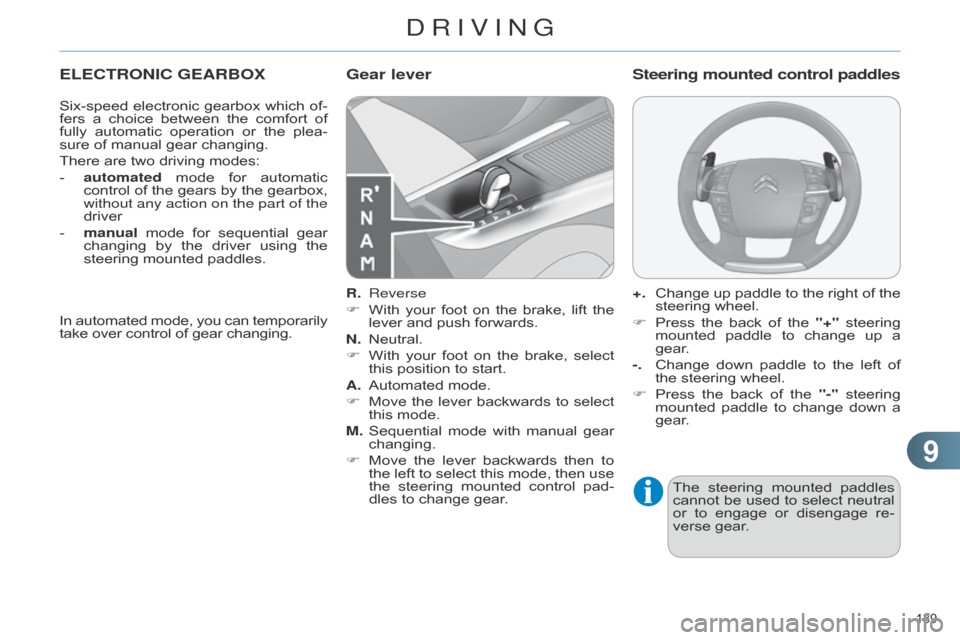
99
139
ELECTRONIC GEARBOX
Six-speed electronic gearbox which of -
fers a choice between the comfort of
fully
automatic
operation
or
the
plea
-
sure
of manual gear changing.
There
are two driving modes:
-
automated
mode
for
automatic
control
of
the
gears
by
the
gearbox,
without any action on the part of the
driver
-
manual
mode
for
sequential
gear
changing
by
the
driver
using
the
steering
mounted paddles.R.
Reverse
F
With
your
foot
on
the
brake,
lift
the
lever
and push forwards.
N.
Neutral.
F
With
your
foot
on
the
brake,
select
this
position to start.
A.
Automated
mode.
F
Move
the
lever
backwards
to
select
this
mode.
M.
Sequential
mode
with
manual
gear
changing.
F
Move
the
lever
backwards
then
to
the
left
to
select
this
mode,
then
use
the
steering
mounted
control
pad
-
dles
to change gear.
Gear lever
+. Change up paddle to the right of the steering
wheel.
F
Press
the
back
of
the
"+"
steering
mounted
paddle
to
change
up
a
gear
.
-.
Change
down
paddle
to
the
left
of
the
steering wheel.
F
Press
the
back
of
the
"-"
steering
mounted
paddle
to
change
down
a
gear
.
Steering mounted control paddles
The steering mounted paddles cannot
be used to select neutral
or
to
engage
or
disengage
re
-
verse
gear.
In
automated
mode,
you
can
temporarily take
over
control
of
gear
changing.
DRIVING
Page 142 of 328
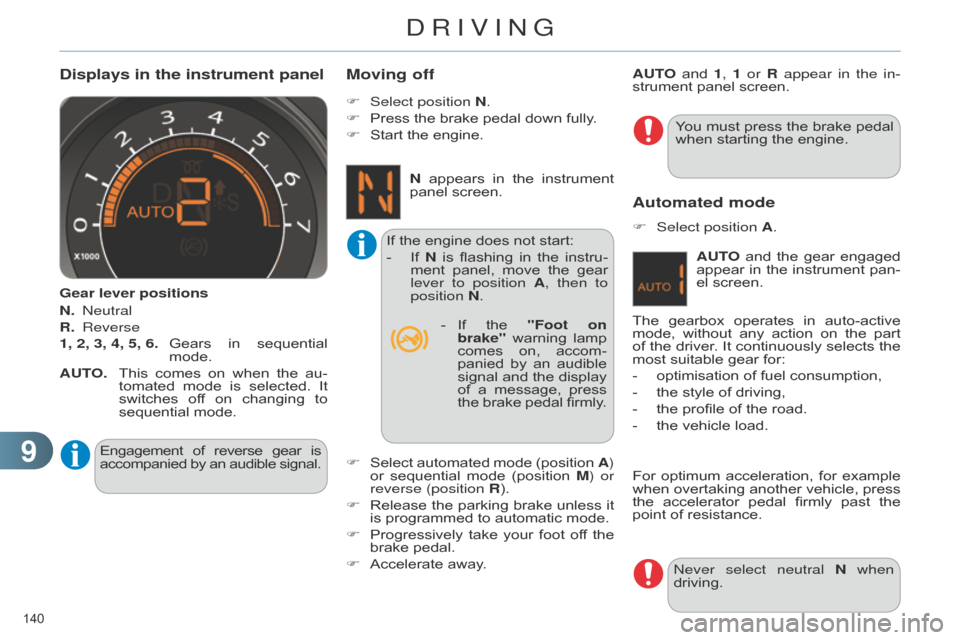
99
140
Displays in the instrument panel
Gear lever positions
N.
n eutral
R.
Reverse
1, 2, 3, 4, 5, 6.
Gears
in
sequential
mode.
AUT
O.
This
comes
on
when
the
au
-
tomated
mode
is
selected.
It
switches
of
f
on
changing
to
sequential
mode. You
must
press
the
brake
pedal
when
starting the engine.
F
Select position
N.
F
Press
the brake pedal down fully.
F
Start
the engine.
Moving off
F Select
automated mode (position A )
or sequential mode (position M ) or
reverse (position R).
F
Release
the
parking
brake
unless
it
is
programmed to automatic mode.
F
Progressively
take
your
foot
of
f
the
brake
pedal.
F
Accelerate
away.
Automated mode
F Select position A.
For
optimum
acceleration,
for
example
when
overtaking
another
vehicle,
press
the
accelerator
pedal
firmly
past
the
point
of resistance.
Engagement
of
reverse
gear
is
accompanied
by
an
audible
signal. If
the
engine
does
not
start:
-
If
N
is
flashing
in
the
instru
-
ment
panel,
move
the
gear
lever to position
A, then to
position N. AUTO
and
1
,
1 or R appear in the in-
strument panel screen.
The
gearbox
operates
in
auto-active
mode,
without
any
action
on
the
part
of
the
driver
.
It
continuously
selects
the
most
suitable gear for:
-
optimisation
of fuel consumption,
-
the
style of driving,
-
the
profile of the road.
-
the
vehicle load.
N
appears
in
the
instrument
panel
screen.
-
If
the
"Foot on
brake"
warning
lamp
comes
on,
accom
-
panied
by
an
audible
signal
and
the
display
of
a
message,
press
the
brake
pedal
firmly
.
n
ever select neutral N when
driving. AUTO
and
the
gear
engaged
appear
in
the
instrument
pan
-
el
screen.
DRIVING
Page 143 of 328
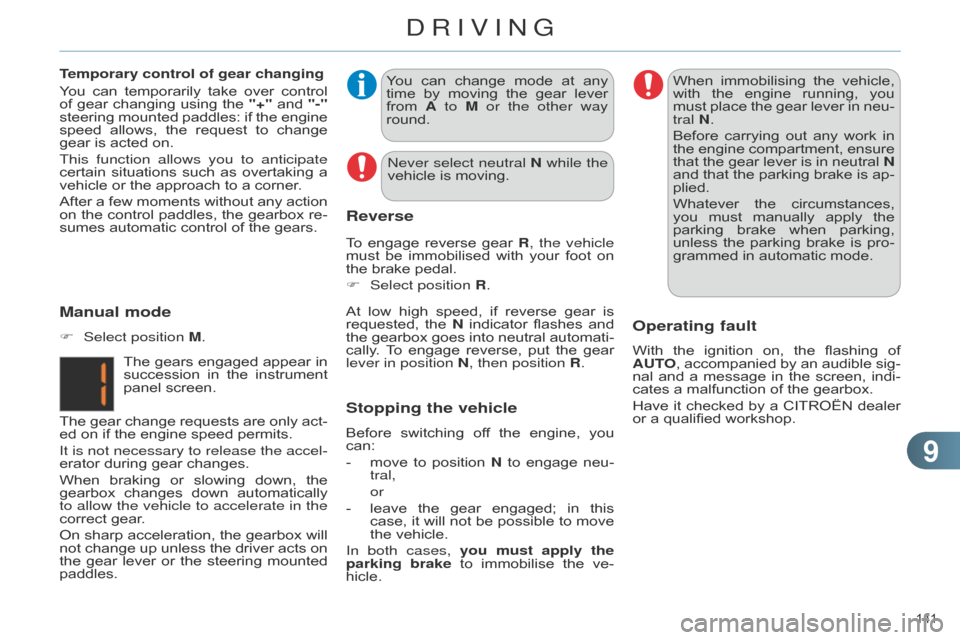
99
141
You can change mode at any time
by moving the gear lever
from
A
to M or the other way
round.
At
low
high
speed,
if
reverse
gear
is
requested,
the
N
indicator
flashes
and
the
gearbox
goes
into
neutral
automati
-
cally.
T
o
engage
reverse,
put
the
gear
lever in position
N, then position R. When
immobilising the vehicle, with
the engine running, you
must
place
the
gear
lever
in
neu
-
tral N.
Before
carrying
out
any
work
in
the
engine
compartment,
ensure
that
the
gear
lever
is
in
neutral N
and
that
the
parking
brake
is
ap
-
plied.
Whatever
the
circumstances,
you
must
manually
apply
the
parking
brake
when
parking,
unless
the
parking
brake
is
pro
-
grammed
in automatic mode.
Reverse
To engage reverse gear R , the vehicle
must be immobilised with your foot on
the
brake pedal.
F
Select position
R.
Operating fault
With the ignition on, the flashing of AUT
O, accompanied by an audible sig -
nal
and
a
message
in
the
screen,
indi
-
cates
a malfunction of the gearbox.
Have
it
checked
by
a
CITROËN
dealer
or
a qualified workshop.
Manual mode
F Select position M.
The
gears
engaged
appear
in
succession
in
the
instrument
panel
screen.
The
gear
change
requests
are
only
act
-
ed
on if the engine speed permits.
It is not necessary to release the accel-
erator
during gear changes.
When
braking
or
slowing
down,
the
gearbox
changes
down
automatically
to allow the vehicle to accelerate in the
correct
gear.
On
sharp
acceleration,
the
gearbox
will
not
change
up
unless
the
driver
acts
on
the
gear
lever
or
the
steering
mounted
paddles. T
emporary control of gear changing
You
can
temporarily
take
over
control
of
gear
changing
using
the
"+"
and
"-"
steering
mounted
paddles:
if
the
engine
speed
allows,
the
request
to
change
gear
is acted on.
This function allows you to anticipate
certain
situations
such
as
overtaking
a
vehicle
or the approach to a corner.
After
a
few
moments
without
any
action
on
the
control
paddles,
the
gearbox
re
-
sumes automatic control of the gears.
n
ever select neutral N while the
vehicle is moving.
Stopping the vehicle
Before switching
of f the engine, you can:
-
move
to
position
N
to
engage
neu
-
tral,
or
-
leave
the
gear
engaged;
in
this
case,
it
will
not
be
possible
to
move
the
vehicle.
In both cases, you must apply the
parking brake
to
immobilise
the
ve
-
hicle.
DRIVING
Page 144 of 328
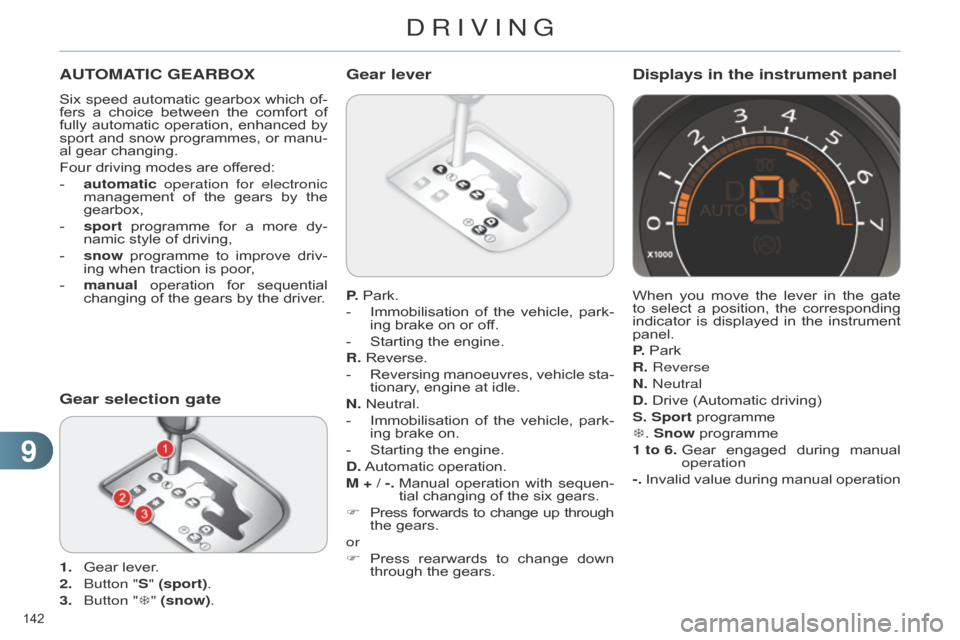
99
142
AUTOMATIC GEARBOX
Six speed automatic gearbox which of -
fers a choice between the comfort of
fully
automatic
operation,
enhanced
by
sport
and
snow
programmes,
or
manu
-
al
gear changing.
Four
driving modes are offered:
-
automatic
operation for electronic
management
of
the
gears
by
the
gearbox,
-
sport
programme
for
a
more
dy
-
namic
style of driving,
-
snow
programme
to
improve
driv
-
ing
when traction is poor,
-
manual
operation
for
sequential
changing
of the gears by the driver.
Gear selection gate
1. Gear lever.
2. b utton "S" (sport).
3.
b utton "T" (snow). P.
Park.
-
Immobilisation
of
the
vehicle,
park
-
ing brake on or off.
-
Starting
the engine.
R. Reverse.
-
Reversing
manoeuvres,
vehicle
sta
-
tionary, engine at idle.
N. Neutral.
-
Immobilisation
of
the
vehicle,
park
-
ing brake on.
-
Starting
the engine.
D.
Automatic
operation.
M + / -.
Manual
operation
with
sequen
-
tial changing of the six gears.
F
Press
forwards
to
change
up
through the
gears.
or
F Press rearwards to change down through
the gears.
Gear lever
When you move the lever in the gate to
select a position, the corresponding
indicator
is
displayed
in
the
instrument
panel.
P.
Park
R. Reverse
N.
n eutral
D.
Drive (Automatic driving)
S. Sport
programme
T.
Snow programme
1 to 6.
Gear
engaged
during
manual
operation
-.
Invalid
value
during
manual
operation
Displays in the instrument panel
DRIVING
Page 145 of 328
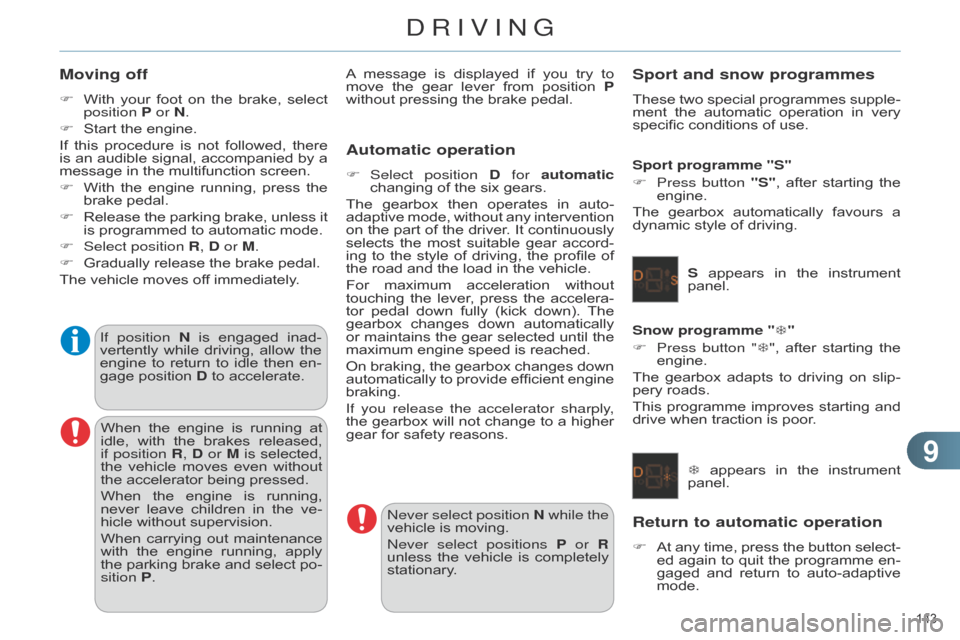
99
143
Moving off
F With your foot on the brake, select position
P or N.
F
Start
the engine.
If
this
procedure
is
not
followed,
there
is
an
audible
signal,
accompanied
by
a
message
in the multifunction screen.
F
With
the
engine
running,
press
the
brake
pedal.
F
Release
the
parking
brake,
unless
it
is
programmed to automatic mode.
F
Select position
R, D or M.
F
Gradually
release the brake pedal.
The
vehicle moves off immediately.
If position N
is
engaged
inad
-
vertently
while
driving,
allow
the
engine
to
return
to
idle
then
en
-
gage
position D to accelerate.
When
the
engine
is
running
at
idle,
with
the
brakes
released,
if position
R, D or M
is
selected,
the
vehicle
moves
even
without
the
accelerator being pressed.
When
the
engine
is
running,
never
leave
children
in
the
ve
-
hicle
without supervision.
When
carrying
out
maintenance
with
the
engine
running,
apply
the
parking
brake
and
select
po
-
sition P. A
message
is
displayed
if
you
try
to
move
the gear lever from position P
without pressing the brake pedal.
n
ever select position N while the
vehicle
is moving.
n
ever select positions P or R
unless
the
vehicle
is
completely
stationary
.
Sport and snow programmes
These two special programmes supple -
ment the automatic operation in very
specific
conditions of use.
Sport programme "S"
F
Press button
"S",
after
starting
the
engine.
The
gearbox
automatically
favours
a
dynamic
style of driving.
S
appears
in
the
instrument
panel.
Snow programme "
T"
F
Press
button "T",
after
starting
the
engine.
The
gearbox
adapts
to
driving
on
slip
-
pery
roads.
This
programme
improves
starting
and
drive
when traction is poor.
T
appears
in
the
instrument
panel.
Return to automatic operation
F At any time, press the button select -
ed again to quit the programme en -
gaged
and
return
to
auto-adaptive
mode.
Automatic operation
F Select position D for automatic
changing of the six gears.
The
gearbox
then
operates
in
auto-
adaptive
mode,
without
any
intervention
on
the
part
of
the
driver
.
It
continuously
selects
the
most
suitable
gear
accord
-
ing
to
the
style
of
driving,
the
profile
of
the
road and the load in the vehicle.
For
maximum
acceleration
without
touching
the
lever
,
press
the
accelera
-
tor
pedal
down
fully
(kick
down).
The
gearbox
changes
down
automatically
or
maintains
the
gear
selected
until
the
maximum
engine speed is reached.
On
braking,
the
gearbox
changes
down
automatically
to
provide
efficient
engine
braking.
If you release the accelerator sharply
,
the
gearbox
will
not
change
to
a
higher
gear
for safety reasons.
DRIVING
Page 146 of 328

99
144
Manual operation
F Select position M for sequential
changing of the six gears.
F
Push
the
lever
towards
the
+
sign
to
change
up a gear.
F
Pull
the
lever
towards
the
-
sign
to
change
down a gear.
It
is
only
possible
to
change
from
one
gear
to
another
if
the
vehicle
speed
and
engine
speed
permit;
otherwise,
the
gearbox
will
operate
temporarily
in
au
-
tomatic
mode.D
disappears
and
the
gears
engaged
appear
in
succes
-
sion
in the instrument panel.
If
the
engine
speed
is
too
low
or
too
high,
the
gear
selected
flashes
for
a
few
seconds,
then
the
ac
-
tual
gear engaged is displayed.
It
is
possible
to
change
from
position
D
(automatic)
to
position
M
(manual)
at
any
time.
When
the
vehicle
is
stationary
or
mov
-
ing
very
slowly
,
the
gearbox
selects
gear
M1 automatically.
The
sport
and
snow
programmes
do
not
operate in manual mode.Invalid value during manual
operation
This symbol is displayed if a
gear
is
not
engaged
correctly
(selector between two posi
-
tions).
Stopping the vehicle
Before switching of f the engine, you can
engage position P or N to place the
gearbox
in neutral.
In
both
cases,
apply
the
parking
brake
to
immobilise
the
vehicle,
unless
it
is
programmed
to automatic mode.
If the lever is not in position P,
when
the
driver's
door
is
opened
or
approximately
45
seconds
after
the
ignition
is
switched
of
f,
there
is
an
audible
signal
and
a
message
appears.
F
Return
the lever to posi-
tion
P
;
the
audible
signal
stops
and
the
message
dis
-
appears. You
risk damaging the gearbox:
-
if
you
press
the
accelera
-
tor
and
brake
pedals
at
the
same
time,
-
if
you
force
the
lever
from
position P
to another position
when
the battery is flat.
When
the
ignition
is
on,
the
lighting
of
this
warning
lamp,
accompanied
by
an
audible
signal
and
a
message
in
the
multifunction
screen,
indicates
a
gear
-
box malfunction.
In
this
case,
the
gearbox
switches
to
back-up
mode
and
is
locked
in
3rd
gear
.
Y
ou
may
feel
a
substantial
knock
when
changing
from
P
to R
and
from
N
to R. This will not cause any damage to the
gearbox.
Do
not
exceed
60
mph
(100
km/h),
lo
-
cal
speed restrictions permitting.
Have
it
checked
by
a
CITROËN
dealer
or
a qualified workshop.
This
warning
lamp
may
also
come
on
if
a
door is opened.
Operating fault
To reduce fuel consumption when
stationary for long periods
with
the
engine
running
(traf
-
fic
jam...),
position
the
gear
le
-
ver at
N
and
apply
the
parking
brake,
unless
it
is
programmed
in
automatic mode.
When
driving
through
flooded
roads
or
crossing
a
ford,
drive
at
walking
speed.
DRIVING
Page 147 of 328
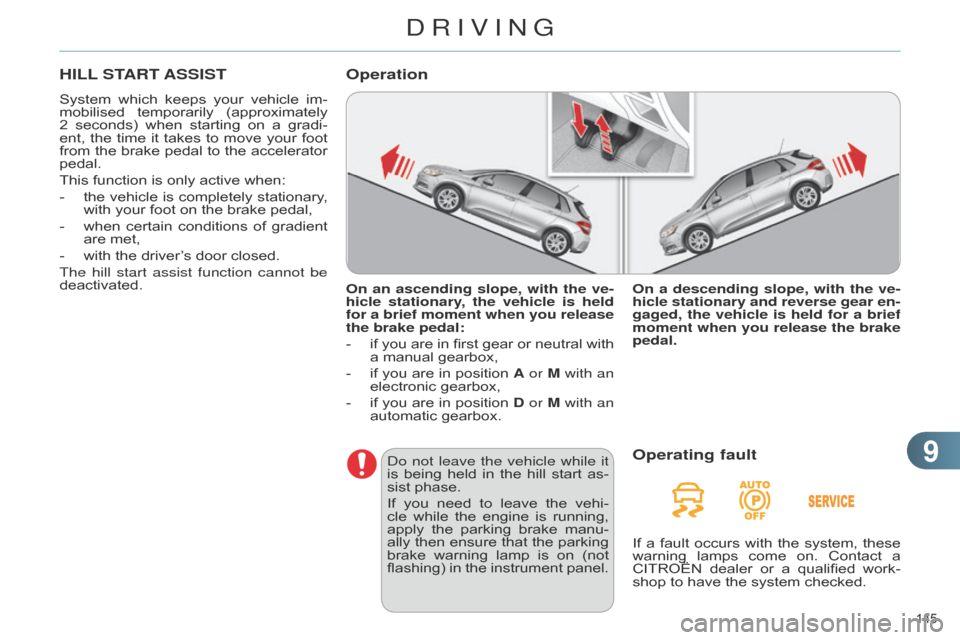
99
145
HILL START ASSIST
System which keeps your vehicle im -
mobilised temporarily (approximately
2
seconds)
when
starting
on
a
gradi
-
ent,
the
time
it
takes
to
move
your
foot
from
the
brake
pedal
to
the
accelerator
pedal.
This
function is only active when:
-
the
vehicle
is
completely
stationary
,
with
your foot on the brake pedal,
-
when
certain
conditions
of
gradient
are
met,
-
with
the driver’s door closed.
The hill start assist function cannot be
deactivated. On an ascending slope, with the ve-
hicle stationary, the vehicle is held
for a brief moment when you release
the brake pedal:
-
if
you
are
in
first
gear
or
neutral
with
a
manual gearbox,
-
if
you
are
in
position
A
or M with an
electronic
gearbox,
-
if
you
are
in
position
D
or M with an
automatic
gearbox.
Operation
do not leave the vehicle while it
is being held in the hill start as -
sist
phase.
If
you
need
to
leave
the
vehi
-
cle
while
the
engine
is
running,
apply
the
parking
brake
manu
-
ally
then
ensure
that
the
parking
brake
warning
lamp
is
on
(not
flashing)
in
the
instrument
panel.On a descending slope, with the ve
-
hicle stationary and reverse gear en-
gaged, the vehicle is held for a brief
moment when you release the brake
pedal.Operating fault
If a fault occurs with the system, these warning
lamps come on. Contact a
CITROËN
dealer
or
a
qualified
work
-
shop
to have the system checked.
DRIVING
Page 148 of 328

99
146
GEAR EFFICIENCY INDICATOR *
Operation
Depending on the driving situation and your
vehicle's equipment, the system
may
advise
you
to
skip
one
(or
more)
gear(s).
Y
ou
can
follow
this
instruc
-
tion
without
engaging
the
intermediate
gears.
The
gear
engagement
recommenda
-
tions
must
not
be
considered
compul
-
sory.
In
fact,
the
configuration
of
the
road,
the
amount
of
traffic
and
safety
remain
determining
factors
when
choosing
the
best
gear
.
Therefore,
the
driver
remains
responsible
for
decid
-
ing
whether
or
not
to
follow
the
advice
given
by the s
ystem.
This
function cannot be deactivated.-
Y ou press the accelerator pedal.
Example:
-
Y
ou are in third gear.
-
The
system
may
suggest
that
you
engage
a higher gear.The
information
appears
in
the
instru
-
ment panel in the form of an arrow.
The system
adapts its gear change
recommendation ac -
cording
to
the
driving
conditions (slope,
load,
...)
and
the
demands of
the
driver
(power
,
acceleration, braking, ...).
The system never suggests:
-
engaging
first gear,
-
engaging
reverse gear.
System
which
reduces
fuel
consump
-
tion
by
recommending
the
most
appro
-
priate
gear.
With
an
electronic
or
automatic
gear
-
box,
the
system
is
only
active
in
manual
mode.
*
Depending
on
engine. On
vehicle
fitted
with
a
manual
gear
-
box,
the
arrow
may
be
accompanied
by
the
gear recommended.
DRIVING
Page 149 of 328
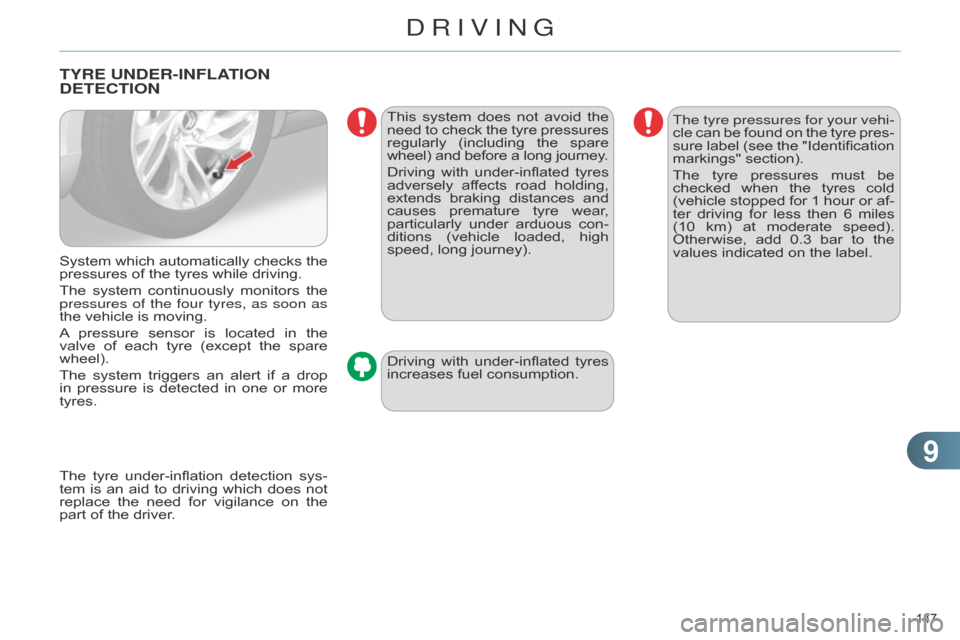
99
147
TYRE UNDER-INFLATION DETECTION
System which automatically checks the pressures
of the tyres while driving.
The
system
continuously
monitors
the
pressures of the four tyres, as soon as
the
vehicle is moving.
A
pressure
sensor
is
located
in
the
valve
of
each
tyre
(except
the
spare
wheel).
The
system
triggers
an
alert
if
a
drop
in
pressure
is
detected
in
one
or
more
tyres. This
system
does
not
avoid
the
need
to
check
the
tyre
pressures
regularly
(including
the
spare
wheel)
and before a long journey.
Driving
with
under-inflated
tyres
adversely
af
fects
road
holding,
extends
braking
distances
and
causes
premature
tyre
wear
,
particularly
under
arduous
con
-
ditions
(vehicle
loaded,
high
speed,
long journey).
Driving
with
under-inflated
tyres
increases
fuel consumption.The tyre pressures for your vehi-
cle
can
be
found
on
the
tyre
pres
-
sure
label
(see
the
"Identification
markings"
section).
The
tyre
pressures
must
be
checked
when
the
tyres
cold
(vehicle
stopped
for
1
hour
or
af
-
ter
driving
for
less
then
6
miles
(10
km)
at
moderate
speed).
Otherwise,
add
0.3
bar
to
the
values
indicated on the label.
The
tyre
under-inflation
detection
sys
-
tem
is
an
aid
to
driving
which
does
not
replace
the
need
for
vigilance
on
the
part
of the driver.
DRIVING
Page 150 of 328

99
148
The flashing and then fixed illu
mination of the under-
inflation
warning
lamp
accom
-
panied
by
the
illu
mination
of
the
service
warning
lamp
indi
-
cates
a fault with the system.
Operating fault
The alert is given by the fixed il -
lumination of this warning lamp, accompanied
by
an
audible signal,
and
depending
on
equip
-
ment,
the
display
of
a
message.
Under-inflation alert
The alert is maintained until the tyre
or tyres concerned is rein -
flated,
repaired or replaced.
The
spare
wheel
(space-saver
type
or
a
steel
rim)
does
not
have
a sensor.
The
loss
of
pressure
detected
does
not
always
lead
to
visible
deformation
of
the
tyre.
Do
not
rely
on just a visual check. This
alert
is
also
displayed
when
one
or
more
wheels
is
not
fit
-
ted
with
a
sensor
(for
example,
a
space-saver
or
steel
spare
wheel).
In
the
event
of
a
problem
on
one
of
the
tyres,
the
symbol
or
the
message
ap
-
pears,
according
to
equipment,
to
iden
-
tify
it. F
Reduce
speed,
avoid
sudden
steer
-
ing
movements
or
harsh
brake
ap
-
plications.
F
Stop
as soon as it is safe to do so.
In
this
case,
monitoring
of
the
tyre
pres
-
sures is not assured.
F
If
you
have
a
compressor
(the
one
in
the
temporary
puncture
repair
kit
for
example),
check
the
four
tyre
pressures
when cold.
If
it
is
not
possible
to
check
the
tyre
pressures
at
the
time,
drive
care
-
fully at reduced speed.
or
F
In the event of a puncture, use the
temporary
puncture
repair
kit
or
the
spare
wheel
(according
to
equip
-
ment).
Go
to
a
CITROËN
dealer
or
a
qualified
workshop
to
have
the
system
checked
or
, following the repair of a puncture, to have
the original wheel, equipped with
a
sensor, refitted.
Any
tyre
repair
or
replacement
on
a
wheel
fitted
with
this
system
must
be
carried
out
by
a
CITROËN
dealer
or
a
qualified
workshop.
If
after
changing
a
tyre,
a
wheel
is
not
detected
by
your
vehicle
(fitting
snow
tyres
for
example),
you
must
have
the
system
reinitialised
by
a
CITROËN
dealer
or a qualified workshop.
DRIVING